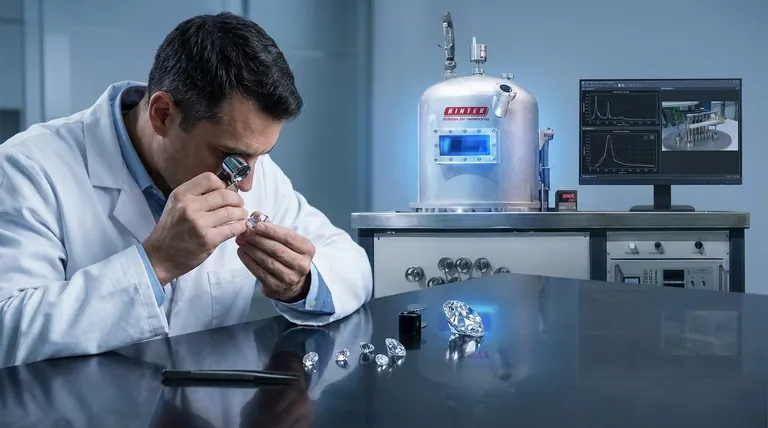No, a jeweler cannot distinguish a lab-grown diamond from a natural one using only their eyes. Because they share the exact same chemical, physical, and optical properties, they are visually identical. Even under a standard jeweler's loupe or microscope, making a definitive identification is nearly impossible without specialized gemological equipment designed to detect subtle differences in their growth characteristics.
The core takeaway is this: A diamond's origin, whether from a lab or the earth, is not a matter of visual inspection but of scientific analysis. Identification requires advanced tools that can detect the microscopic clues left behind by the diamond's unique formation process.

Why Visual Inspection Fails
The challenge of distinguishing lab-grown from natural diamonds stems from the fact that, fundamentally, they are the same material. The differences are not in their substance but in their origin story, which leaves behind subtle, microscopic markers.
Identical Chemical and Physical Properties
A lab-grown diamond is not a "fake" diamond. It consists of pure carbon crystallized in the same isometric system as a mined diamond.
As a result, it has the same hardness (10 on the Mohs scale), the same refractive index (brilliance), and the same thermal conductivity. The Federal Trade Commission (FTC) recognizes both as real diamonds.
Indistinguishable to the Naked Eye
Because their core properties are identical, light behaves the same way when passing through a lab diamond as it does through a natural one. This means their fire, sparkle, and brilliance are indistinguishable to an observer, regardless of their expertise.
The Tools and Techniques for True Identification
Gemologists and reputable jewelers do not rely on visual guesswork. They use advanced equipment and scientific principles to make a conclusive identification.
Examining Growth Patterns and Structure
Natural diamonds form over billions of years under immense, chaotic pressure, typically resulting in octahedral growth patterns.
Lab diamonds are created in weeks or months in a controlled environment. This process leaves behind different, more uniform growth patterns that can be detected with specialized imaging equipment.
Analyzing Inclusions
Inclusions are tiny imperfections within a diamond. The type of inclusion often reveals the diamond's origin.
Natural diamonds may contain tiny crystals of other minerals that were trapped during formation. In contrast, lab-grown diamonds can have metallic flux inclusions—microscopic remnants of the metal crucible they were grown in.
The "Type IIa" Test
One of the strongest indicators is a diamond's "type." Type IIa diamonds are the most chemically pure, containing virtually no nitrogen impurities.
While less than 2% of natural diamonds are Type IIa, the majority of gem-quality lab-grown diamonds are. A test confirming a diamond is Type IIa makes it highly likely to be lab-grown, though it's not a 100% guarantee. This test requires the stone to be unmounted.
Understanding the Limitations and Pitfalls
While identification is possible, it's crucial to understand the limitations of a casual appraisal and where the real certainty comes from.
A Standard Loupe is Not Enough
A jeweler's loupe is a powerful magnifying tool for assessing a diamond's cut, clarity, and color (the 4Cs). However, it is generally not sufficient to identify the subtle growth patterns or inclusion types that definitively prove a diamond's origin.
The Definitive Proof: A Grading Report
The most reliable way to know a diamond's origin is to have it professionally graded.
Reputable gemological laboratories like the GIA (Gemological Institute of America) or IGI (International Gemological Institute) use sophisticated equipment to test every diamond they grade. Their reports will explicitly state if the diamond is "Laboratory-Grown" or "Natural."
Making the Right Choice for Your Goal
When buying or assessing a diamond, your approach should be guided by what you need to know.
- If your primary focus is visual beauty: Rest assured there is no visual difference between a lab and a natural diamond of the same quality; your choice is purely about origin and budget.
- If your primary focus is absolute certainty of origin: Rely exclusively on a grading certificate from a major, reputable gemological lab, not a jeweler's visual opinion alone.
- If you are evaluating an uncertified stone: Understand that a skilled jeweler can look for indicators, but a conclusive identification may require sending it to a specialized lab for advanced testing.
Ultimately, the distinction between a lab and a natural diamond is not in what you can see, but in the scientific story it tells under expert analysis.
Summary Table:
| Method | Capability | Required Equipment |
|---|---|---|
| Visual Inspection (Naked Eye/Loupe) | Cannot Distinguish | Jeweler's Loupe |
| Analysis of Growth Patterns | Can Distinguish | Specialized Imaging Equipment |
| Analysis of Inclusions | Can Distinguish | Advanced Microscopy |
| Type IIa Test | Strong Indicator | Spectroscopic Equipment |
| Professional Grading Report | Definitive Proof | Lab Equipment (GIA, IGI) |
Need precise, reliable identification for your diamonds? KINTEK specializes in advanced laboratory equipment and consumables essential for modern gemological analysis. Our tools provide the accuracy and certainty required to distinguish between lab-grown and natural diamonds, empowering jewelers and gemologists with definitive results. Enhance your lab's capabilities and ensure customer confidence—contact our experts today to find the perfect solution for your needs.
Visual Guide

Related Products
- HFCVD Machine System Equipment for Drawing Die Nano-Diamond Coating
- 915MHz MPCVD Diamond Machine Microwave Plasma Chemical Vapor Deposition System Reactor
- CVD Diamond Domes for Industrial and Scientific Applications
- CVD Diamond Cutting Tool Blanks for Precision Machining
- Small Vacuum Heat Treat and Tungsten Wire Sintering Furnace
People Also Ask
- How do you calculate coating coverage? A Practical Guide to Accurate Material Estimation
- What is direct current DC magnetron sputtering? A Guide to High-Quality Thin Film Deposition
- What is the hot filament chemical vapour deposition of diamond? A Guide to Synthetic Diamond Coating
- How do CVD diamonds grow? A Step-by-Step Guide to Lab-Grown Diamond Creation
- What machine is used to make lab-grown diamonds? Discover the HPHT & CVD Technologies



















